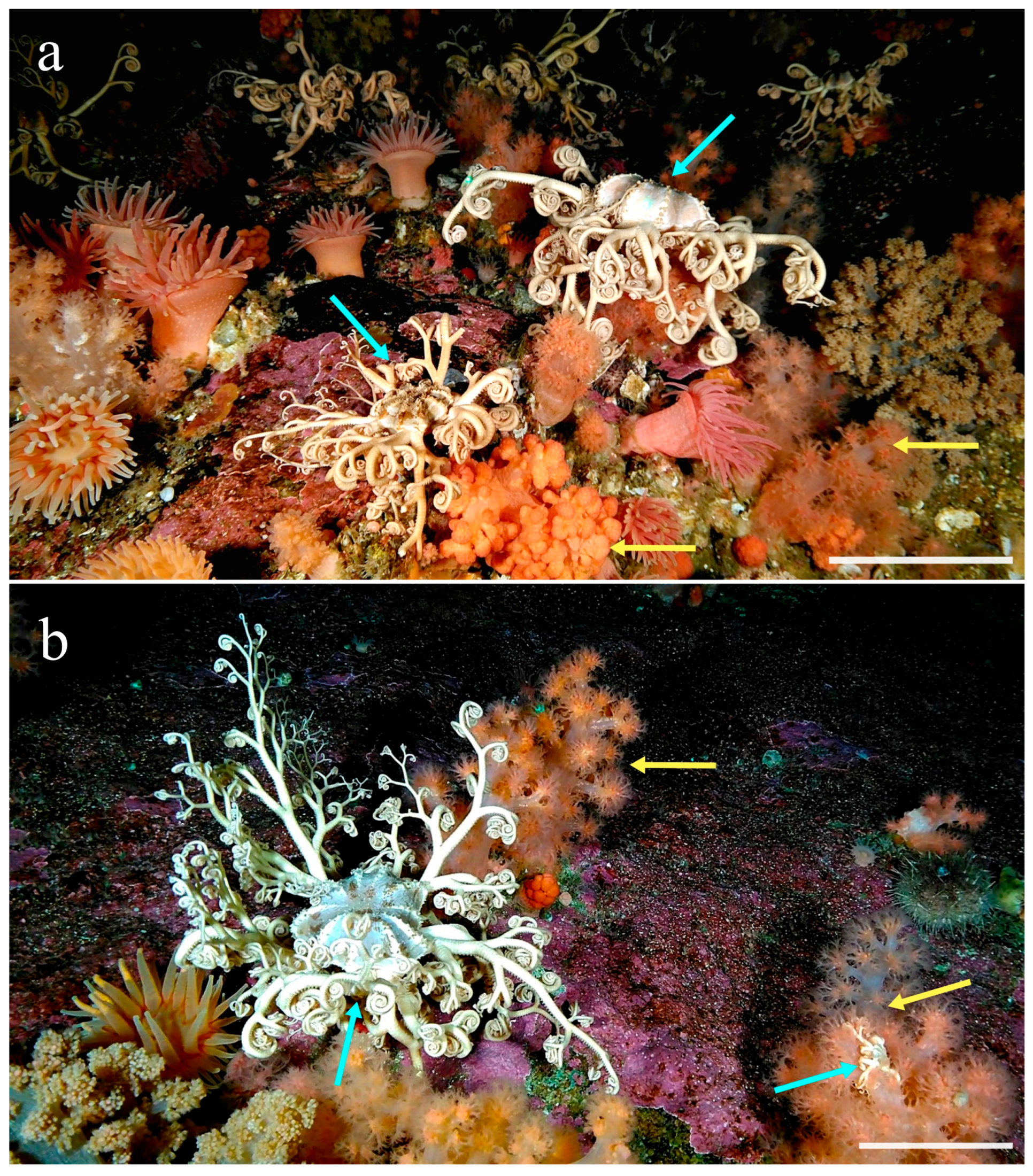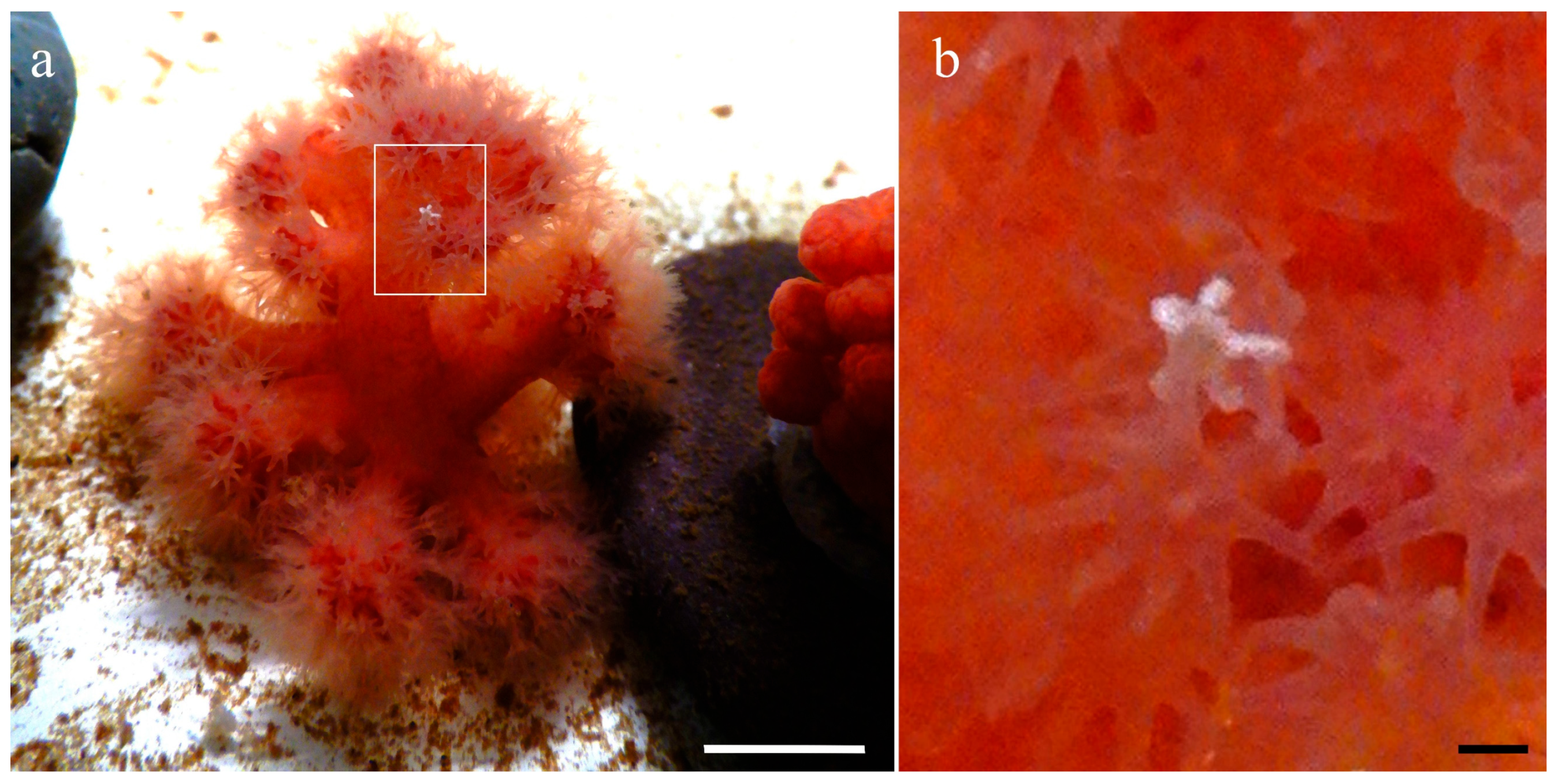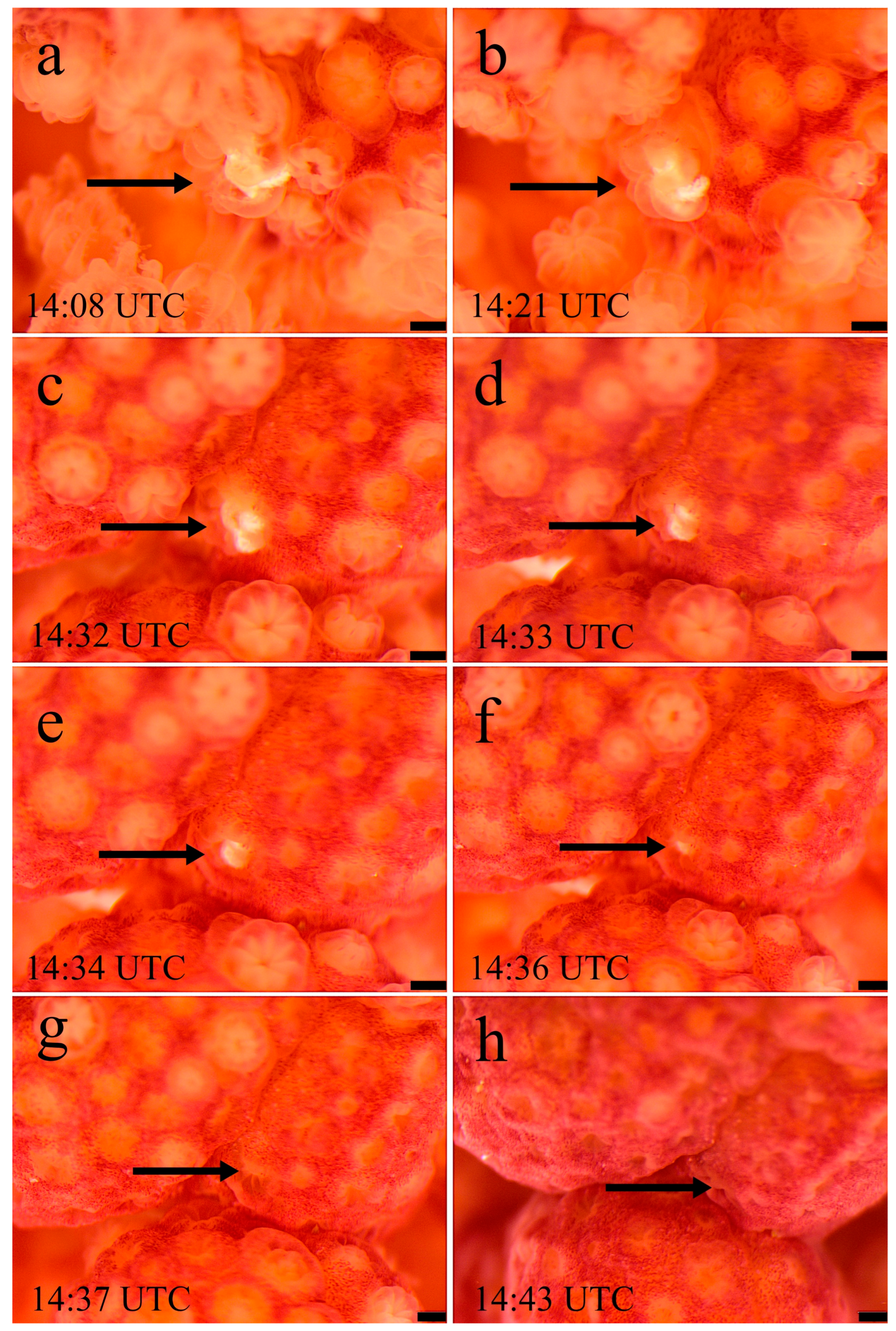Gorgonocephalid basket stars (Ophiuroidea: Gorgonocephalidae) are suspension-feeding echinoderms found in benthic habitats ranging from tropical (>20 °C) [
1,
2] to arctic (<2 °C) [
3,
4] and shallow (<100 m) [
1,
2] to deep-sea depths (>250 m) [
3,
4], making this group prevalent in many marine environments worldwide. They can grow to reach large sizes (10 cm disc diameter) [
5] and have been identified as highly vulnerable to disturbance such as bottom trawling [
6]. Despite this, much is to be learned regarding their growth and early life history, especially in cold-water environments where ophiuroids may be long-lived [
7]. For instance, longevity in the Arctic ophiuroid
Ophiopleura borealis Danielssen & Koren, 1877, was estimated at >30 years old [
7].
The role of cold-water soft corals (Octocorallia: Alcyoniidae and Nephtheidae) as a nursery habitat for basket stars (
Gorgonocephalus sp.) has been identified by researchers since the early 1900s [
4,
5,
8]; however, the extent of the corals’ involvement in the early development of juvenile basket stars has only been hypothesized. Fedotov [
8] first reported tiny (0.4 mm disc diameter)
Gorgonocephalus individuals protruding from the polyps of
Drifa glomerata (Verrill, 1869) (published as
Gersemia glomerata Verrill, 1869). At this stage of development, the basket stars were described as “helpless” with simple, unbranching arms [
8] as full mobility was not yet acquired. The prevailing theory presented by Fedotov [
8] was that basket star development begins with the attachment of planktonic larvae to the coral, where metamorphosis occurs, and the resulting juvenile lives attached to or within the polyp until a disc diameter of ~0.6 mm. Juveniles with a disc diameter of ≥0.6 mm were thought to live on the outside of the polyp [
8]. During this dependent stage of development, Fedotov [
8] reasoned that the polyps potentially provide both protection and nutrition to the basket star, with the ophiuroid’s mouth directly atop the polyp’s mouth. Patent [
5] found six
Gorgonocephalus eucnemis (Müller & Troschel, 1842) individuals (0.72 mm disc diameter) inside the pharynx of
Gersemia sp. polyps and smaller individuals (0.48 mm disc diameter) living on the coral, outside of the polyp. Patent’s hypothesis was that the young basket stars use the coral polyps to access nutrition by feeding on ingested material while inside the polyp, and while living outside the polyp, individuals were sometimes observed with an arm in the pharynx of a polyp.
To further investigate this relationship, basket stars and octocoral colonies of
Gersemia rubiformis (Ehrenberg, 1834) were opportunistically collected on 24 October 2024 during an expedition to the Funk Island Deep Marine Refuge (
Figure 1, NW Atlantic, 49°47.154′ N, 53°6.340′ W and 49°48.279′ N, 53°12.515′ W, stations 11 and 15, respectively) at depths of ~100 m using a Naturalist’s dredge. Our goal was to closely observe live colonies of
G. rubiformis with juvenile basket stars over several weeks to better understand their association. Seafloor imagery was previously collected in Funk Island Deep adjacent to the collection stations in June 2024 using a drop camera system equipped with a SubC benthic rayfin underwater camera, two 15,000-lumen LED lamps and 10 cm scaling lasers. Seafloor imagery confirmed the presence of both adult and juvenile basket stars in the region (
Figure 1). Collected basket stars and
G. rubiformis were kept alive in seawater for two days onboard until they were transferred to the Northwest Atlantic Fisheries Centre (Fisheries and Oceans Canada, St. John’s, NL, Canada). Here they were kept together in a fibreglass tank (0.9 m diameter) with flow-through, unfiltered seawater at a rate of ~500 L h
−1 and originating from an intake depth of 30 m. Temperature ranged between 2 and 6 °C during observations, dissolved oxygen between 91 and 103% and salinity between 31.4 and 32.1 psu. Photoperiod (light and dark hours) followed that of the region.
Seven weeks after collection (15 December 2024), a juvenile basket star (~0.5 mm disc diameter) was discovered with its arms wrapped around the oral disc of a coral polyp (
Figure 2). While we did not collect the basket star for species identification, we assume that it belongs to
Gorgonocephalus due to the known association between juvenile basket stars and these soft corals in the region [
4] and the presence of
Gorgonocephalus at the study site during sampling (
Figure 1). The colony was observed in seawater under a stereomicroscope, and the polyps (along with the basket star) retracted within the colony. The next time the colony was observed in an expanded state, 2 days after the initial observation, the basket star was observed under the microscope again, still wrapped around the face of the polyp. The polyp, with its tentacles wrapped around the basket star, retracted inside the colony once again over the course of 5 min (
Figure 3). The juvenile basket star was observed still on the polyp when the colony was once again expanded. For the next months, this pattern continued, where the juvenile basket star was only visible when the polyps of the colony were extended. This pattern was observed a second time in February 2025, with a different juvenile basket star (~0.7 mm disc diameter) on another colony.
Figure 1.
Basket stars (Gorgonocephalus sp.) and soft corals in situ at Funk Island Deep Marine Refuge (a). Photo showing apparent adult basket star (left) and juvenile basket star on Gersemia rubiformis (right) in situ (b). Blue arrows point to basket stars. Yellow arrows point to G. rubiformis (both contracted and expanded colonies seen). The soft coral Drifa glomerata is also seen. Scale bars represent ~10 cm. Photo credit: Fisheries and Marine Institute, Memorial University of Newfoundland and Labrador.
Figure 1.
Basket stars (Gorgonocephalus sp.) and soft corals in situ at Funk Island Deep Marine Refuge (a). Photo showing apparent adult basket star (left) and juvenile basket star on Gersemia rubiformis (right) in situ (b). Blue arrows point to basket stars. Yellow arrows point to G. rubiformis (both contracted and expanded colonies seen). The soft coral Drifa glomerata is also seen. Scale bars represent ~10 cm. Photo credit: Fisheries and Marine Institute, Memorial University of Newfoundland and Labrador.
Figure 2.
Photo of Gersemia rubiformis in laboratory tank with rectangle highlighting juvenile basket star holding polyp (a). Photo zoomed in (b). Scale bars represent ~1 cm and ~500 µm, respectively.
Figure 2.
Photo of Gersemia rubiformis in laboratory tank with rectangle highlighting juvenile basket star holding polyp (a). Photo zoomed in (b). Scale bars represent ~1 cm and ~500 µm, respectively.
Figure 3.
Sequential images showing the juvenile basket star retracting with the polyp into the colony of
Gersemia rubiformis. The basket star observed on the oral disc of the polyp and the polyp with its tentacles around the basket star (
a,
b). The retraction of the basket star into
G. rubiformis (
c–
g).
Gersemia rubiformis shown with its polyps fully retracted (
h). Arrows indicate the location of basket star. See
Figure 2 for the location of the basket star and polyps relative to the whole colony. Scale bars represent 500 µm.
Figure 3.
Sequential images showing the juvenile basket star retracting with the polyp into the colony of
Gersemia rubiformis. The basket star observed on the oral disc of the polyp and the polyp with its tentacles around the basket star (
a,
b). The retraction of the basket star into
G. rubiformis (
c–
g).
Gersemia rubiformis shown with its polyps fully retracted (
h). Arrows indicate the location of basket star. See
Figure 2 for the location of the basket star and polyps relative to the whole colony. Scale bars represent 500 µm.
In addition to corroborating earlier research describing soft corals as important nursery for early-life stages of basket stars, our observations suggest that juvenile basket stars may benefit from the retractile nature of the polyps in
G. rubiformis, and survive within the colony (even if outside the polyp). This could allow them to take advantage of the reaction of the colony to a stimulus (e.g., a predator), when they have not yet developed full mobility to escape threats on their own. Further studies are required to investigate this hypothesis. Other cold-water soft coral species with non-retractable polyps such as
Drifa glomerata and
Duva florida (Rathke, 1806) also provide habitat for juvenile basket stars, and even at higher occurrences than
G. rubiformis [
4]. But our observations highlight the importance of species-specific attributes to the soft coral-basket star dynamics. Our study expands on the knowledge about the extent to which young basket stars appear to be dependent on the coral host for survival, and suggests that they may continue to reap benefits of protection from the polyps after they outgrow the ability to live within the pharynx of the polyp itself, until they grow too large to retract into the colony.








